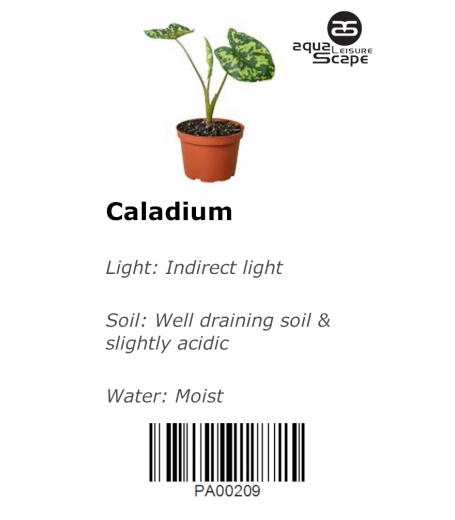Caladiums, also called elephant ears, are tropical perennial plants with large, showy, heart- or arrow-shaped, paper-thin leaves in various colors and patterns. They are mainly grown for their white, green, red, and pink mottled, striped, or veined leaves. Caladiums grow best in warm, humid conditions with bright, filtered light, acidic soil, and temperatures between 60 degrees Fahrenheit (night) and 75 F (day). Caladiums are toxic to animals and humans.
| Common Name | Caladium, elephant ears |
| Botanical Name | Caladium spp. |
| Family | Araceae |
| Plant Type | Tropical perennial |
| Mature Size | 12–30 in. tall, 12–24 in. wide |
| Sun Exposure | Indirect light (indoors), full to partial shade (outdoors) |
| Soil Type | Rich, well-drained |
| Soil pH | Acidic (5.5-6.2) |
| Bloom Time | Spring, summer, fall |
| Flower Color | Green, pink, white, red |
| Hardiness Zones | 9–11 (USDA) |
| Native Area | Central America, South America |
| Toxicity | Toxic to people and pets12 |
Light
Caladium plants prefer indirect light or moderate shade indoors. The narrower the leaves, the greater the sun they can withstand. Growing them outdoors in containers gives you more control over light conditions. Some newer cultivars can be grown in full sun, but most caladiums need protection from too much intense light. When growing them in a garden, give them partial to full shade; full sun scorches their leaves.3
Unless you live in zones 9 to 11, you should plan to grow them as annuals or dig up the plants' tubers at the end of the growing season and store them for the winter.
Soil
Plant caladium in rich, well-drained soil in the garden or a potting mix for containers, such as a damp mix of soil and peat. Garden soil should be similarly rich and well-drained. The ideal soil pH is slightly acidic, at 5.5 to 6.2.
Water
When leaves appear on the plant, water as needed to keep the soil evenly moist. Never let the plant dry out, as leaves may turn yellow and drop. If growing outdoors during peak heat, water every day.
Stop watering the plant when the leaves start to die back. Resume watering in spring after winter dormancy. New leaves will reappear as temperatures warm.
Temperature and Humidity
Caladiums are seasonal tuberous plants, even in the tropics. Gardeners plant them in the spring after the threat of frost or in the summer, where they thrive in heat and humidity. When grown indoors, they do best with lots of heat, bright but indirect light, and plenty of moisture.
Caladiums grow best from spring into autumn, peaking in the summer. The warmer, the better for caladium houseplants. Aim for 70 to 75 degrees Fahrenheit during the day and 60 to 65 degrees at night, as that is the temperature at which tubers begin to grow. Keep the humidity as high as is practical.
When planting outdoors, you can transplant potted tubers (or, better yet, transfer them in peat pots) after the last frost date for your area. Plants grown this way should be started indoors for four to six weeks before transplanting in warm soil. Caladiums' rest period comes in the autumn or winter. It isn't determined by temperature or light cycle but by how long the plants have been growing.
Fertilizer
Fertilize the plant every two weeks during the growing season with liquid fertilizer or use slow-release pellets.
Reviews
There are no reviews for this product.



